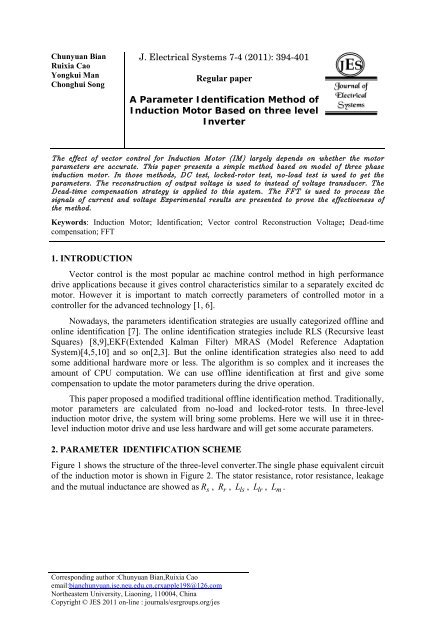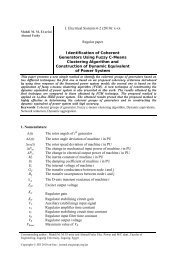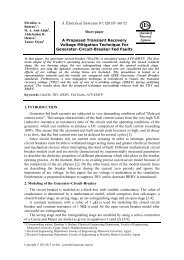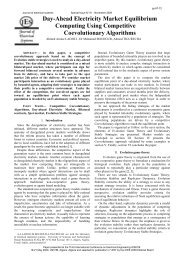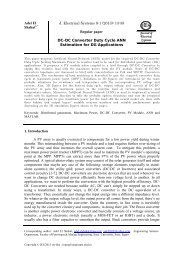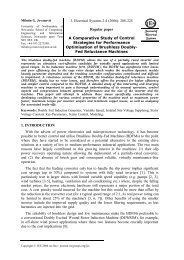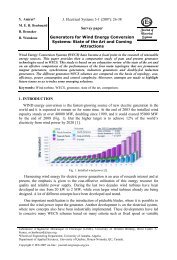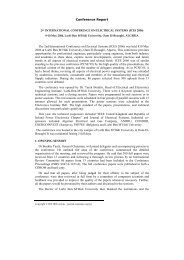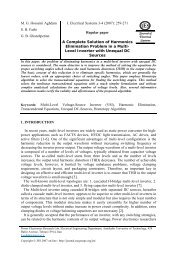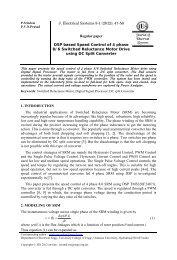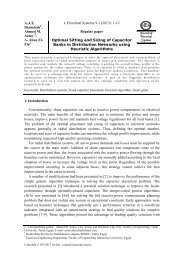Regular paper A Parameter Identification Method of Induction Motor ...
Regular paper A Parameter Identification Method of Induction Motor ...
Regular paper A Parameter Identification Method of Induction Motor ...
You also want an ePaper? Increase the reach of your titles
YUMPU automatically turns print PDFs into web optimized ePapers that Google loves.
J. Electrical Systems 7-4 (2011): 394-4012.1 <strong>Identification</strong> <strong>of</strong> Stator ResistanceStator resistance is measured by DC test. We let IGBTS (S1, S2, S7, S8, S11, S12) beconducted and IGBTS (S3, S4, S5, S6, S9, S10) be <strong>of</strong>f all the time. In this case, we will getsome pulse voltage to the induction motor. The equivalent circuit model shown in Figure2can be simplified to the model in Figure3. In order to get the correctly stator resistance, hereiais DC current .The DC voltage <strong>of</strong> the induction must be low, because the stator resistanceis very small.aR sRsU abRsbFigure 3: Equivalent circuit <strong>of</strong> DC testThe stator resistance can be given by (1)2UabRs= (1).3iaWhere U ab can be the line voltage <strong>of</strong> the induction motor, i a can be the current <strong>of</strong>stator <strong>of</strong> phase A. Traditionally, voltage <strong>of</strong> the stator is measured by two voltage transducersand low-pass filters are needed to remove the high-frequency PWM harmonics from thevoltage measurements. Inevitably the low-pass filter will introduce a phase shift and themeasurements can also suffer from the inherent inaccuracy <strong>of</strong> the voltage transducers,especially at low voltages. For a regularly sampled PWM voltage-source inverter (VSI),phase voltages can be reconstructed from the PWM reference signals. Dead-timecompensation method will be used in vector control. We can get correctly voltage.395
Chunyuan Bian et al: A <strong>Parameter</strong> <strong>Identification</strong> <strong>Method</strong> <strong>of</strong> <strong>Induction</strong> <strong>Motor</strong> ...Figure 4 provides the scheme <strong>of</strong> DC test.Figure 4: Control structure diagram <strong>of</strong> DC test2.2 Locked-rotor TestRotor resistance and leakage inductance are measured by locked-rotor test.Theequivalent circuit model shown in Figure2 can be simplified to the model in Figure 5.1.5Rs 1.5L1s 1.5Rr 1.5L1rU abFigure 5: Equivalent circuit <strong>of</strong> one-phase testWe do locked-rotor test as the DC test. The only difference is that i ais AC current.The Figure4 also provides the scheme <strong>of</strong> locked-rotor test.So we can get the results.Lls= L =lrRr2 2( U ab / ia ) − ( uab / iacos θ )6 fπ(2)uab= cos θ *2 / 3 − R(3)Siiais ac current. We also can get U ab through the reconstruction.2.3No-load TestThe mutual inductance is measured by no-load test. No-load test is to allow the rotorshaft with no load. We use V/F to control ac machine. The speed <strong>of</strong> the induction was closeto synchronous speed and slip S is approximately zero. So the equivalent circuit modelshown in Figure2 can be simplified to the model in Figure 6.i aRsaL1sU abL mFigure 6: Equivalent circuit <strong>of</strong> no-load test396
J. Electrical Systems 7-4 (2011): 394-401The mutual inductance can be found.Lm = ( Uab / ia)sin θ /2/ pi/f − Lls(4)The Figure7 shows the scheme <strong>of</strong> no-load test. We also can get U throughabreconstruction. i a is phase current. We can get θ through FFT.Figure 7:Control structure diagram <strong>of</strong> no-load test3.THE VOLTAGE CALCULATION3.1 Reconstruction <strong>of</strong> Output VoltageTraditionally, the machine’s phase voltages are measured by two voltage transducers anlow-pass filters are needed to remove the high-frequency pulse width modulation (PWM)harmonics from the voltage measurements. Inevitably, the low-pass filter will introduce aphase shift and the measurements can also suffer from the inherent inaccuracy <strong>of</strong> the voltagetransducers, especially at low voltages. For a regularly sampled PWM voltage-sourceinverter (VSI), the phase voltages can be estimated from the PWM reference signals.The fundamental components <strong>of</strong> the three-phase voltage applied to the inductionmachine can be calculated as follows:⎧di a⎪ua = u ax − u n = iar + l + e adt⎪di b⎨ u = u − u = i r + l + e(5)b bx n bb⎪dt⎪di cu c = u cx − u n = icr + l + ec⎪⎩dtu a, u b, u care the phases voltage <strong>of</strong> the induction machine. u az, u bz, u are theczphase voltage to the ground . u n is neutral point voltage to ground.The equation (6) can be written asU + U + U − 3UWe can getaz= ( i+ eaa⎧ i⎨⎩e+ i+ eaabzbb+ i+ ec+ eccznd ( ia+ i ) r + Lbb+ ic+ ec= 0= 0+ idtb+ i )c(6)(7)397
Chunyuan Bian et al: A <strong>Parameter</strong> <strong>Identification</strong> <strong>Method</strong> <strong>of</strong> <strong>Induction</strong> <strong>Motor</strong> ...Because s3= 1−s1; s4 = 1−s2; s7 = 1−s5;s8 1−s 6= ; s11 = 1−s9; s12 = 1−s10, we obtainWe can also get the Output Voltage.ua + ub + uc= 0(8)1un= ( ua+ ub+ uc)3(9)⎡ua⎤ ⎡2 −1 −1⎤⎡uaz⎤⎢ 1u⎥ ⎢b 1 2 1⎥ ⎢ ⎥⎢ ⎥= ubz3⎢ − −⎥⎢ ⎥⎢uc1 1 2 ⎢ u ⎥⎣ ⎥⎦ ⎢⎣−− ⎥⎦⎣ cz⎦(10)⎧ 1 1 1⎪uaz=udcs1s2− udcs3s4=udc(s1+ s2−1)2 2 2⎪ 1 1 1⎨ ubz=udcs5s6− udcs7s8=udc(s5+ s6−1)⎪ 2 2 2⎪ 1 1 1uaz=udcs9s10−udcs11s12=udc(s9+ s10−1)⎪⎩2 2 2⎧⎪u⎪⎨u⎪⎪u⎪⎩aaa1= u61= u61= u6dcdcdc(2s1(2s5(2s9+ 2s2+ 2s6+ 2s10− s5− s1− s− s− s162− s− s− s299− s5− s− s1010))− s )3.2 Dead-time Compensation StrategyIn inverters, dead-time must be inserted in switching signals to prevent a short circuitin the DC link. Although dead-time guarantees safe operation <strong>of</strong> the inverter, it causes aserious distortion in the output voltages. It results in a momentary loss <strong>of</strong> control, and theoutput voltage deviates from the reference voltage. Since this is repeated for everyswitching operation, its effect may be come significant. This is known as the dead-timeeffect. This effect is still apparent even with the recently developed fast switching devices.Therefore, the understanding <strong>of</strong> the dead-time effect is crucial to the improvement <strong>of</strong> theperformance <strong>of</strong> PWM inverters.The formula (14) gives us the way to get a strategy <strong>of</strong> dead time compensation.TdUdcΔ ux=− sign( ix)× (13)T 24 EXPERIMENTAL RESULTSWe make these experiments though DSP 28335 and CPLD.The parameters <strong>of</strong> the inductionmachine used in the experiments are shown in Table I .s6(11)(12)398
J. Electrical Systems 7-4 (2011): 394-401Table. I. The parameters os the induction machinepower 2.2kw voltage 380current 5.05A p 2f 50HZ n 1410λ 2.1 cosθ 0.824.1DC Test ResultWe measure the value <strong>of</strong> the voltage and current and get the waveform <strong>of</strong> voltage,current, and stator resistance as followsia= 2AUab= 22.3 VFigure 8 :Waveform <strong>of</strong> currentFigure 9. Waveform <strong>of</strong> line voltageR s = 7.44ΩFigure10. Stator resistanceVoltage fluctuation is only 0.5V , Current fluctuation is only 0.1A. So we get thestator resistance near 7.4.4.2Locked-rotorTest ResultWe get the stable current and calculate the value <strong>of</strong> the voltage. We use FFT to getamplitudes <strong>of</strong> voltage, current and power factor angle.ia= 0.73AUab= 42.6Vf= 50HZf= 50HZFigure11. Waveform <strong>of</strong> currentFigure 12. Waveform <strong>of</strong> line Voltage399
Chunyuan Bian et al: A <strong>Parameter</strong> <strong>Identification</strong> <strong>Method</strong> <strong>of</strong> <strong>Induction</strong> <strong>Motor</strong> ...R r = 8.6Ω Lls= Llr= 0.561HFigure13. Rotor resistanceFigure14. Leakage inductance4.3No-load TestWe get the stable current and calculate the value <strong>of</strong> the voltage. We use FFT to getamplitudes <strong>of</strong> voltage, current and power factor angle.Uab= 227Via= 0.88Af= 50HZf= 50HZFigure15. Waveform <strong>of</strong> line VoltageFigure16. Waveform <strong>of</strong> currentFigure17. The mutual inductanceFrom these experiments we can get the results as Table II.Table. II. Table <strong>of</strong> the resultsparameters Actual value Measured valueR S 7.44 Ω 7.4 ΩR r8.523 Ω 8.6 ΩL ls =L lr0.056H 0.0561HL m1.047H 1.04H5. CONCLUSIONSThis <strong>paper</strong> proposes a novel parameter identification method for a general inverter-fedinduction motor system at standstill state. This <strong>paper</strong> has the following features:1) Reconstruction <strong>of</strong> Output Voltage instead <strong>of</strong> using voltage transducer.2) The Dead-time compensation strategy is applied to this system.3) The FFT is used to process the singals <strong>of</strong> current and voltage.400
J. Electrical Systems 7-4 (2011): 394-401ACKNOWLEDGMENTThe author would like to thank the reviewers constructive comments. Thank theNational Science Foundation (60974141 ) and the Natural Science Foundation <strong>of</strong> LiaoningProvince(20092007) to support this project.REFERENCES[1] M.L.Camobell,etal, “Speed Sensorless <strong>Identification</strong> <strong>of</strong> the Rotor Time Constant in <strong>Induction</strong> Machine”.IEEE Trans .Automatic Control, 2007,52:758-763.[2] Rasmus K.Ursem, Pierre wadstrup. “<strong>Parameter</strong> identification <strong>of</strong> induction motors using stochasticoptimization algorithms” [J]. Applied S<strong>of</strong>t Computing, 2004:49-64.[3] R.N.Conte, L.F.A.Pereira, J.F.Haffner. “<strong>Parameter</strong>s <strong>Identification</strong> <strong>of</strong> <strong>Induction</strong> Machines Based onFrequency Response and Optimization Techniques”[J], The 29th Annual Conference <strong>of</strong> the IEEE.Vol.1,November 2003: 596-599[4] Cui Naxin, Zhang Chenghui, Li Ke, Zhang chengjin, “Efficiency optimization control <strong>of</strong> induction motordrives based on online parameter estimation”, Transactions <strong>of</strong> China Electroe ChncalSociety,v22,n9,September,2007: 80-85.[5] H. M. Kojabadi, L.Chang, R. Doraiswami. “A novel adaptive observer for very fast estimation <strong>of</strong> statorresistance in sensorless induction motor drives”[J], Proceedings <strong>of</strong> IEEE 34th Annual Power ElectronicsSpecialist Conference, 2003, 3:1455-1459.[6] Bastiaensen Cindy, Deprez Wim, Driesen Johan , “<strong>Parameter</strong> sensitivity and measurement uncertaintypropagation in torque-estimation algorithms for induction machines”. IEEE Transactions on Instrumentationand Measurement , v57, n 12, 2008: 2727-2732.[7] Stefopoulos GeorgeK.,Sakis MeliopoulosA.P. “Numerical parameter estimation procedure for three phaseinduction motor models”,2007 IEEE Lausanne POWERTECH, Proceedings, 2007:1111-1116.[8] M.Cirrincione,M.Pucci,G.Cirrincione, and G.A.Capolino, “A new experimental application <strong>of</strong> least-squarestechniques for the estimation <strong>of</strong> the induction motor parameters, IEEE Transactions on Industry Applications,vol.39,pp.1247–1256,September/October 2003.[9] M.Ruff and H.Grotstollen, “<strong>Identification</strong> <strong>of</strong> the Saturated Mutual Inductance <strong>of</strong> an Asynchronous <strong>Motor</strong> atStandstill by Recursive Least Squares Algorithm”, 5th European Conference on Power Electronics andApplications, Brighton, U.K.,Vol.5pp.103 108. ,1993[10] K.Wang,J.Chiasson,M.Bodson,and .M.Tolbert, “An online rotor time constant estimator for the inductionmachine”, Control Systems Technology, IEEE Transaction son, vol.15,no.2,pp.339–348, March 2007401


